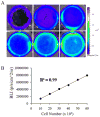Novel microRNA prosurvival cocktail for improving engraftment and function of cardiac progenitor cell transplantation
- PMID: 21911815
- PMCID: PMC3181082
- DOI: 10.1161/CIRCULATIONAHA.111.017954
Novel microRNA prosurvival cocktail for improving engraftment and function of cardiac progenitor cell transplantation
Abstract
Background: Although stem cell therapy has provided a promising treatment for myocardial infarction, the low survival of the transplanted cells in the infarcted myocardium is possibly a primary reason for failure of long-term improvement. Therefore, the development of novel prosurvival strategies to boost stem cell survival will be of significant benefit to this field.
Methods and results: Cardiac progenitor cells (CPCs) were isolated from transgenic mice, which constitutively express firefly luciferase and green fluorescent protein. The CPCs were transduced with individual lentivirus carrying the precursor of miR-21, miR-24, and miR-221, a cocktail of these 3 microRNA precursors, or green fluorescent protein as a control. After challenge in serum free medium, CPCs treated with the 3 microRNA cocktail showed significantly higher viability compared with untreated CPCs. After intramuscular and intramyocardial injections, in vivo bioluminescence imaging showed that microRNA cocktail-treated CPCs survived significantly longer after transplantation. After left anterior descending artery ligation, microRNA cocktail-treated CPCs boost the therapeutic efficacy in terms of functional recovery. Histological analysis confirmed increased myocardial wall thickness and CPC engraftment in the myocardium with the microRNA cocktail. Finally, we used bioinformatics analysis and experimental validation assays to show that Bim, a critical apoptotic activator, is an important target gene of the microRNA cocktail, which collectively can bind to the 3'UTR region of Bim and suppress its expression.
Conclusions: We have demonstrated that a microRNA prosurvival cocktail (miR-21, miR-24, and miR-221) can improve the engraftment of transplanted cardiac progenitor cells and therapeutic efficacy for treatment of ischemic heart disease.
Conflict of interest statement
Figures







References
-
- Gonzales C, Pedrazzini T. Progenitor cell therapy for heart disease. Exp Cell Res. 2009;315:3077–3085. - PubMed
-
- Waksman R, Baffour R. Bone marrow and bone marrow derived mononuclear stem cells therapy for the chronically ischemic myocardium. Cardiovasc Radiat Med. 2003;4:164–168. - PubMed
-
- Dai W, Hale SL, Martin BJ, Kuang JQ, Dow JS, Wold LE, Kloner RA. Allogeneic mesenchymal stem cell transplantation in postinfarcted rat myocardium: Short- and long-term effects. Circulation. 2005;112:214–223. - PubMed
-
- Kolossov E, Bostani T, Roell W, Breitbach M, Pillekamp F, Nygren JM, Sasse P, Rubenchik O, Fries JW, Wenzel D, Geisen C, Xia Y, Lu Z, Duan Y, Kettenhofen R, Jovinge S, Bloch W, Bohlen H, Welz A, Hescheler J, Jacobsen SE, Fleischmann BK. Engraftment of engineered es cell-derived cardiomyocytes but not bm cells restores contractile function to the infarcted myocardium. J Exp Med. 2006;203:2315–2327. - PMC - PubMed
Publication types
MeSH terms
Substances
Grants and funding
LinkOut - more resources
Full Text Sources
Other Literature Sources
Medical

